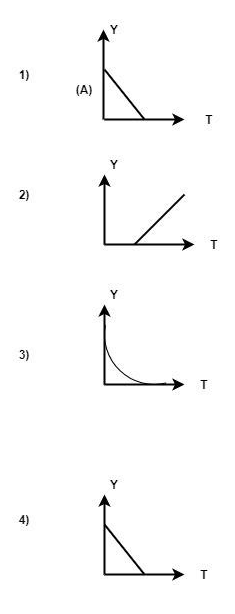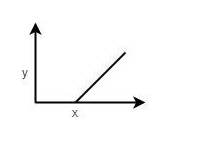
A hot liquid is kept inside in a big room. Rate of cooling of liquid is plotted against its temperature T. Which of the following curves may represent the plot?


Answer
570.3k+ views
Hint:Here we know that if we keep a hot liquid in a big room the temperature of the hot liquid falls down. Assume that the temperature of the room is at room temperature. Use Newton law of cooling and plot the graph and then match it with a given option.
Formula used:The rate of cooling of temperature is given by the formula:-
$\dfrac{{dQ}}{{dt}} = \dfrac{{kA(\Delta T)}}{{dx}}$ ;
Where:
\[\dfrac{{dQ}}{{dt}} = {\text{ Rate of change of heat}} = ms\Delta T\] ; m = Mass; s = Specific Heat; $\Delta T$= Change in temperature.
k= Constant;
$\Delta T/dx$= Temperature gradient;
$\Delta T = \dfrac{{d\theta }}{{dt}}$ = Rate of change of Cooling.
A = Boundary Surface;
Complete step-by-step answer:
Plot the graph by Newton's law of cooling.
The formula is given as:
$\dfrac{{dQ}}{{dt}} = \dfrac{{kA(\Delta T)}}{{dx}}$
Put the value of Q in the equation:
$ms\Delta T = \dfrac{{kA(\dfrac{{{\theta _1} + {\theta _2}}}{2} - {\theta _o})}}{{dx}}$; ($\Delta T$=$(\dfrac{{{\theta _1} + {\theta _2}}}{2} - {\theta _o})$ )
Put the value of $\Delta T = \dfrac{{d\theta }}{{dt}}$in the above equation.
$ms\dfrac{{d\theta }}{{dt}} = \dfrac{{kA(\dfrac{{{\theta _1} + {\theta _2}}}{2} - {\theta _o})}}{{dx}}$;
Take me to the RHS and solve.
$\dfrac{{d\theta }}{{dt}} = \dfrac{{kA}}{{dx \times ms}}(\dfrac{{{\theta _1} + {\theta _2}}}{2} - {\theta _o})$;
First find out the value of x,
Put the value of y =0,
At x we have a coordinate$\dfrac{{kA{\theta _o}}}{{dx \times ms}}$;
So we will get the graph for y i.e. the rate of cooling of temperature.

Final Answer:Option “2” is correct.
Note:Here, the intuitive answer would be option number3 but that is not the correct option. Here we have to apply the Newton law of cooling which has a specific formula and that has to apply in this question to get the desired graph.
Formula used:The rate of cooling of temperature is given by the formula:-
$\dfrac{{dQ}}{{dt}} = \dfrac{{kA(\Delta T)}}{{dx}}$ ;
Where:
\[\dfrac{{dQ}}{{dt}} = {\text{ Rate of change of heat}} = ms\Delta T\] ; m = Mass; s = Specific Heat; $\Delta T$= Change in temperature.
k= Constant;
$\Delta T/dx$= Temperature gradient;
$\Delta T = \dfrac{{d\theta }}{{dt}}$ = Rate of change of Cooling.
A = Boundary Surface;
Complete step-by-step answer:
Plot the graph by Newton's law of cooling.
The formula is given as:
$\dfrac{{dQ}}{{dt}} = \dfrac{{kA(\Delta T)}}{{dx}}$
Put the value of Q in the equation:
$ms\Delta T = \dfrac{{kA(\dfrac{{{\theta _1} + {\theta _2}}}{2} - {\theta _o})}}{{dx}}$; ($\Delta T$=$(\dfrac{{{\theta _1} + {\theta _2}}}{2} - {\theta _o})$ )
Put the value of $\Delta T = \dfrac{{d\theta }}{{dt}}$in the above equation.
$ms\dfrac{{d\theta }}{{dt}} = \dfrac{{kA(\dfrac{{{\theta _1} + {\theta _2}}}{2} - {\theta _o})}}{{dx}}$;
Take me to the RHS and solve.
$\dfrac{{d\theta }}{{dt}} = \dfrac{{kA}}{{dx \times ms}}(\dfrac{{{\theta _1} + {\theta _2}}}{2} - {\theta _o})$;
First find out the value of x,
Put the value of y =0,
At x we have a coordinate$\dfrac{{kA{\theta _o}}}{{dx \times ms}}$;
So we will get the graph for y i.e. the rate of cooling of temperature.

Final Answer:Option “2” is correct.
Note:Here, the intuitive answer would be option number3 but that is not the correct option. Here we have to apply the Newton law of cooling which has a specific formula and that has to apply in this question to get the desired graph.
Recently Updated Pages
Why are manures considered better than fertilizers class 11 biology CBSE

Find the coordinates of the midpoint of the line segment class 11 maths CBSE

Distinguish between static friction limiting friction class 11 physics CBSE

The Chairman of the constituent Assembly was A Jawaharlal class 11 social science CBSE

The first National Commission on Labour NCL submitted class 11 social science CBSE

Number of all subshell of n + l 7 is A 4 B 5 C 6 D class 11 chemistry CBSE

Trending doubts
10 examples of friction in our daily life

One Metric ton is equal to kg A 10000 B 1000 C 100 class 11 physics CBSE

Difference Between Prokaryotic Cells and Eukaryotic Cells

1 Quintal is equal to a 110 kg b 10 kg c 100kg d 1000 class 11 physics CBSE

State the laws of reflection of light

Explain zero factorial class 11 maths CBSE




